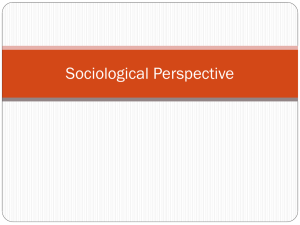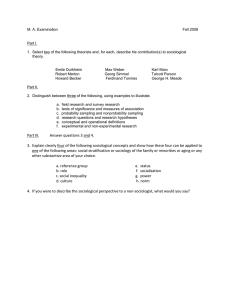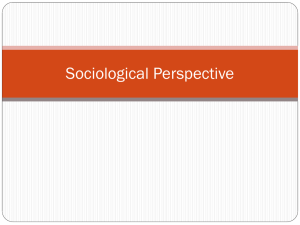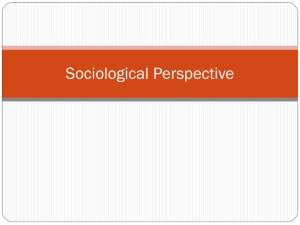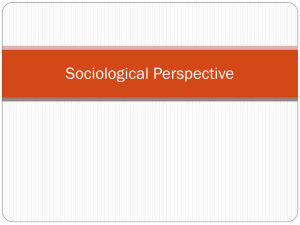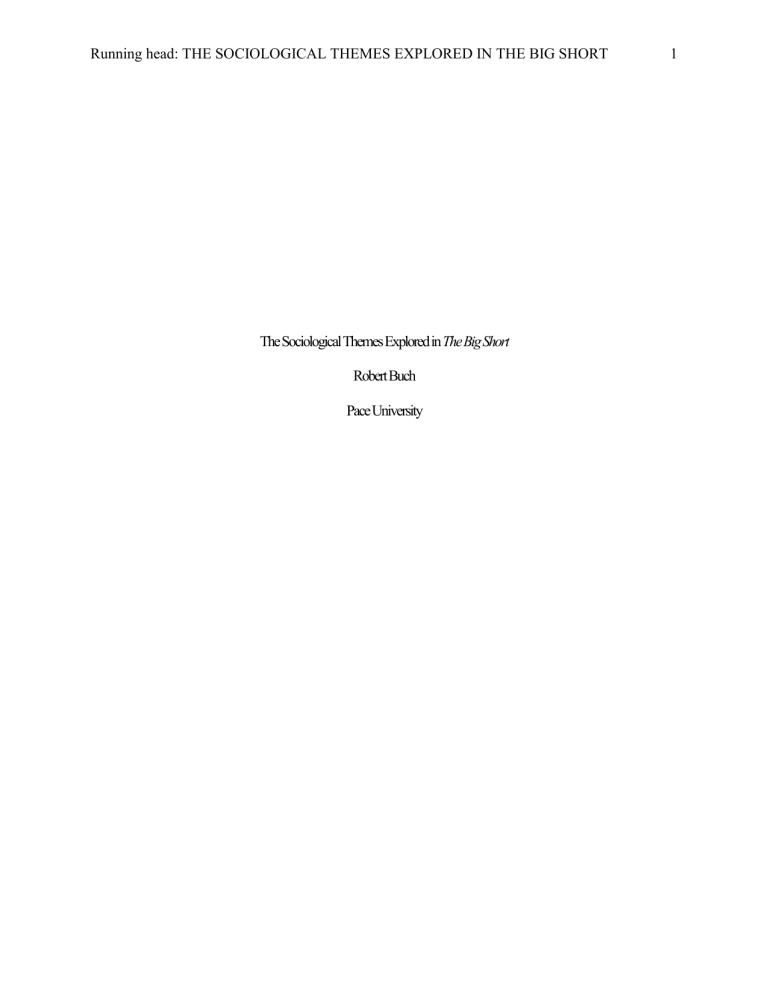
Running head: THE SOCIOLOGICAL THEMES EXPLORED IN THE BIG SHORT The Sociological Themes Explored in The Big Short Robert Buch Pace University 1 THE SOCIOLOGICAL THEMES EXPLORED IN THE BIG SHORT 2 The Sociological Themes Explored in The Big Short “Money, not morality, is the principle commerce of civilized nations.” ~ Thomas Jefferson (Frank, 2014, p. 349) The 2015 motion picture The Big Short is based on the true story of the causes and reality of the housing crash of 2008 and follows the stories of a handful of individuals that saw it coming and wagered big money that the bubble would burst. Although most of the subprime loan rates went up in 2007, the banking industry hid the losses from the public for another year in an effort to stave off their impending failure. The three stories followed in the film originate with Dr. Michael Burry (Christian Bale) as the single person who actually saw the signs of the forthcoming collapse and his actions – putting $1.3 billion into shorting the mortgage bonds – initiate the other two groups that bet against the market. He recognized the housing bubble for what it was, which is an initially self-reinforcing but eventually self-defeating process (Bradford, 2016). Mark Baum (Steven Carell) and his team of investors who work under the Morgan Stanley umbrella and Charlie Gellar and Jamie Shipley (John Magaro and Finn Wittrock), who operate a fund called Brownfield and are assisted by Ben Rickert (Brad Pitt). These three groups stood to gain millions when the market failed, and the film follows them through the reality of Wall Street corruption and fraud. The “most obvious culprit in the . . . economic quagmire is the errors of judgment made by managers of banks and other financial institutions” (Gaffney, 2009, p. 983). Due to the fact that a film “as a product is exhibited to audiences removed in both place and time from the context of production and the morality of exhibition of ethnographic film”, it is a metaphor for society at any given point in time (Tomaselli & Shepperson, 1997, p. 44). The sociological theories of conflict, structural functionalist, and symbolic interactionism are each evident in specific scenes throughout the film, along with other sociological themes. These themes include the neutralization of deviancy, the globalization of capitalism, public social issues, authoritarian selection, and morality and ethics of society as a whole and Wall Street in particular. The film is an exemplary example of how social issues permeate every aspect of life, particularly ones that are a cross-section of society as a whole and a microcosm of the entire system in its most vulnerable moments. THE SOCIOLOGICAL THEMES EXPLORED IN THE BIG SHORT 3 Conflict theory is essentially the proletariats versus the bourgeoise, the wage earners versus the elite, the home buyers versus the big banks that funded them. It is the competition for scarce resources and shows how the elite control the poor and the weak (Henslin, 2017). The movie makes it clear that the poor were exploited and used in an effort to generate large profits in the short term. Near the beginning of the film, Baum is investigating the rumor that there is a housing bubble and decided to talk to actual real estate agents to see what is happening: AGENT 1: The bonuses on [subprime loans] skyrocketed a few years ago. Adjustables are bread and honey. BAUM: So, do applicants ever get rejected? AGENT 1: Seriously? AGENT 2: Look if they get rejected, I suck at my job! BAUM: Even if they have no money? AGENT 1 Well, my firm offers a NINJA loan. No income no job [or assets], I just leave the incomesection blank if I want. Corporate doesn't care. These people just want homes, and they go with the flow. BAUM: Your companies don't verify? AGENT 2: If I write a loan on Friday afternoon, big bank is gonna buy it by Monday lunch. …Deal! AGENT 1: Same here! These loan officers specifically target poor people with bad credit – specifically immigrants and strippers. Agent 1 says that the advantages of targeting immigrants are that they do not speak English and they do not understand the rates, “They sign where you tell them to sign.” Agent 2 feels that immigrants have credit that “isn’t bad enough,” and instead goes after strippers because, “no one on the pole has good credit and they’re all cash-rich.” This scene is the epitome of how the big banks go against the workers, and part of what Marx thought would drive the revolution to overthrow the elite. Wall Street followed its own prescription for American business. Wall Street was seduced by the overvalued financial instruments and THE SOCIOLOGICAL THEMES EXPLORED IN THE BIG SHORT 4 financial culture that appeared to be economic nirvana (Anderson, 2009). Even though the corruption was apparent to everyone, the banks prevailed and became even stronger than before. Though many large banks failed – Bear Stearns, Lehman Brothers, and Countrywide – the ones that survived are stronger than ever. The common saying, “Too big to fail,” was made into a movie to explain the collapse and became the mantra of the entire banking industry. For structural functionalists, similar to symbolic interactionism, the function of one group depends on the function of another and the entire world collapse was based on these groups not functioning properly, with people who could not afford the homes they bought knowingly being sold something they could not pay for because they did not understand the fine print. The crash traveled around the world due to the globalization of capitalism. As Ben Rickert says near the end of the film when on the phone with Jamie and Charlie, “The largest bank in France froze its customers’ money-market Accounts today. This thing is hitting Europe! Greece and Iceland are finished, Spain is teetering.” Along with globalization came the related “phenomenon of financialization in which the financial sector grew larger as a percentage of economic activity and expanded it influence over the rest of the political economy” (Deeg & O’Sullivan, 2009, p. 731). Sadly, the default rates were going up before the bulk of adjustable rate hikes in 2007 as Burry saw the consequences coming in 2005. He noticed that fraud rates were on the rise. As Baum’s team discovered during their initial investigation into the market, even people who were paying their rent were at stake because while the renter paid the rent, the landlord did not pay the mortgage. In fact, the property owner filled out the loan application using the name of his dog and the bank let him. The functions between the bank and the property owner failed so the functions between the property owner and the renter failed, leaving one more family homeless. In the U.S. alone, $5 trillion in losses, eight million unemployed, and six million homeless, as each function failed, causing the failure of the next. Per the functionalist perspective, “work is what binds us together” (Henslin, 2017, p. 407). The elites figured out a way to keep themselves in power. While Marx, the founder of conflict theory, believed that property was the key to social stratification and class, Weber argued that Marx missed vital elements of what separates the elites from the poor. Weber said that social class has three components: class, power, and status, or property, power, and prestige (Henslin, 2017). THE SOCIOLOGICAL THEMES EXPLORED IN THE BIG SHORT 5 Relationships are the foundation of symbolic interactionism, and the entire United States economy is interrelated and when one group fails, it cascades down to another, then another, and so forth. There were people among Wall Street that bet against the market, but they did it to make money, not to correct the problem, and the realities of what it meant if their bets paid off did not occur to most of them. Ben Rickert, on the other hand, understood all too well. After Jamie and Charlie strike a deal on mortgage shorts, Ben confronts them in a Las Vegas casino: BEN: Stop it, stop! JAMIE: What? BEN: Do you have any idea what you just did? CHARLIE: Come on, we just made the deal of our lifetime, we should celebrate! BEN: You just bet against the American economy! JAMIE: Fuck yeah, we did! CHARLIE Yeah! BEN: Which means! CHARLIE Fuck yeah! Oh! BEN: Which means...If we're right...If we're right, people lose homes! People lose jobs! People lose retirement savings, people lose pensions! You know what I hate about fucking banking! It reduces people to numbers! Here's a number! Every one percent unemployment goes up, 40 thousand people die! Did you know that?! Did you know that? CHARLIE: No, I didn't know that! JAMIE: We were just excited! BEN: Just don't fucking dance! This makes it clear the social context of the effects of the actions of a handful of corrupt Wall Streeters and what it will do to society as a whole while at the same time emphasizing the individual and how each person will be affected. It is how the THE SOCIOLOGICAL THEMES EXPLORED IN THE BIG SHORT 6 relationships between one sector impact the others. And society’s own obliviousness to the reality in front of them. Symbolic interactionism uses symbols and the subjective meanings attached to them as well as face-to-face interactions. It directs sociologists to consider the symbols and details of everyday life as people act according to the subjective meaning attached to the symbols (Aalbers, 2009). As Baum says, “everybody is walking around like they're in a goddamn Enya-video. They're all getting screwed you know! You know what they care about? They care about the ballgame! Or they care about what actresses went into rehab!” They simply did not want to see what was happening the same way they did not read the fine print on each loan. Society’s larger denial of reality is another factor that contributed to the crash as each one stumbled over the next as relationship after relationship failed. But each one is someone’s individual story: one family’s struggle to regain their dignity and footing on such shaky ground. Another way to view these three theories is to examine them on a wider scale. The housing collapse was heralded by massive fraud – cultural deviancy – and once the market crashed, the stress and strain that all subprime mortgage holders went through gave way to anomie. This is a theory coined by Durkheim, labeling anomie as a “condition of society in which people become detached from usual norms and guide their behavior” (Henslin, 2017, p. 270). The cultural norm that stated that, in Lewis Raneiri’s words, “they’re mortgages, and who . . . doesn’t pay their mortgage?” (The Big Short, 2015). Once the collapse hit in the spring of 2008, the cultural norms broke down rapidly due to these changes. It became standard for owners in default to simply abandon their homes and their belongings. When Porter and Danny (two members of Baum’s team), initially went to Miami to investigate and determine the truth about the housing market, they found only four residents in a complex of over a hundred high-end homes. They discovered house after house stacked with overdue mortgage bills and the owners’ belongings as owners grabbed a handful of items and left everything else behind. One intrepid family even left behind their pet alligator in the pool. These homeowners succumbed to anomie under strain theory. It became the new accepted norm for people to simply walk away. Structural functionalism and conflict theory are both macro-sociological while symbolic interactionism is microsociological. Each one of the three stories is an example of a different theory. The conflict theory is represented by Jamie, THE SOCIOLOGICAL THEMES EXPLORED IN THE BIG SHORT 7 Charlie, who run a fund too small to make their own short bets on the market and need the help of a former trader to get their ISDA license to trade “at the big boy table.” This is the proletariat going against the bourgeoise as each tried to upend the other in an effort to get all they can. Even though the pair represent the little guy, they only study the broader picture when making the decisions on their investments. They look at the mortgages and CDOs overall, the macro-image, when the bigger picture defines each relationship. The other macro-theory is structural functionalism, which is represented by Burry. He realized there was a housing bubble when he saw that the rise in housing prices was uncorrelated with other factors like interest rates, land value, construction costs, employment, and wages (Auerbach, 2017). He saw the signs of the imminent market collapse based on the history of the American economy and that just before the Great Depression, there was a record amount of fraud committed. He observed in 2005 that the fraud rate was on the rise, giving him just one clue as to the impending doom. While he did read the mortgage bonds, he did not consider the individual story but instead relied on an overview and average to make his decisions. In contrast, Baum and his team heard about the potential for large profits for shorting the mortgage market, but instead of depending on the larger picture, they traveled to Miami to see a new housing project and try to talk to homeowners more than 90 days late on their mortgages. They looked for the individual story, and the fact that they find very few people actually living in the housing complex helps to confirm that the bubble exists. Their final decision is made when they interview a stripper and discuss her mortgage reality with her: BAUM: Ok, look…If home-prices don't go up, you are not going to be able to refinance and you're going to be stuck paying whatever your monthly payment is once it jumps up, whenever your teaserrate expires your monthlies could go up two-to three hundred percent! STRIPPER: James says I can always refinance! BAUM: Well... he's... a liar. Actually, in this particular case, James probably is just wrong. STRIPPER: Two-hundred percent? On all my loans? BAUM: What do you mean? We're talking about two loans on one house, right? STRIPPER: I have five houses and a condo… THE SOCIOLOGICAL THEMES EXPLORED IN THE BIG SHORT 8 This individual story advises Baum on the overall picture and helps him to decide. Unlike the other two groups, Baum was not satisfied to merely take the word of spreadsheets and legal documents before investing millions. The three groups together present a full picture of sociological theories and how each are structured in the film. Crenshaw’s idea of intersectionality is minimal in the film as it is dependent on gender and racial crossings and the movie is primarily comprised on middle-aged white men. The point of intersectionality is to understand the variety of both oppression and privileges that one may experience at any given time. The racial and ethnic inequalities in homeownership have only worsened since the crisis. Just like minorities have not had the same access as Caucasians, Wall Street is composed of white males (Kuebler, 2012). The one female Wall Street character referred to by name is an African American woman that supervises Baum’s fund at Morgan Stanley. Even her they turn into a gender-stereotype as her story is about her baby, even though the movie never shows her pregnant. The saddest concept is the blatant racism displayed by the film’s only other minority: BAUM: How come nobody's talking about this? VINNIE: And you're completely sure of the math? VENNETT: Look at him...That's my quant! VINNIE: Your what? VENNETT: My quantitative... my math specialist! Look at him! You notice anything different about him? Look at his face! Look at his eyes! I'll give you a hint.. His name is Yang! He won a national math competition…In China! He doesn't even speak freakin’ English! Yeah! I'm sure of the math. JEONG: Actually, my name is Jeong, and... I do speak English. Jared likes to say I don’t... Because he thinks it makes me seem more authentic and... I got second in that national math competition. This is the epitome of racial stereotypes, a blatant and obvious one. Jeong is the only Asian in the film, and all the main characters, and most of the people they interact with, are white males. This is not the racism of the film industry but rather the racism of Wall Street, since each of these characters is based on a real-life person in the industry. THE SOCIOLOGICAL THEMES EXPLORED IN THE BIG SHORT 9 According to Mills, the sociological perspective is that each relationship is influenced by another and by society as a whole; and each relationship in society influences the individual. The people virtually unseen in this film are the poor, but they are the ones most affected. Even the banks that lost everything were not as taken advantage of as the poor as the bank made the conscious effort to go into subprime loans to begin with. The housing market went up, up, and up, and no one every thought it would come down. As Baum reacts to the mortgage agents’ revelations of who they target for loans – immigrants and strippers – Baum is baffled: BAUM: I don't get it...Why are they confessing? PORTER: They're not confessing... DONNY: They're bragging! Baum does not realize that the agents are so happy about committing fraud and taking advantage of the poor, so they could make more money. As Agent 2 tells him, “Two years ago, I was a bartender. Now I own a boat.” The bankers and mortgage lenders did this to the economy knowingly, perhaps not understanding the wider repercussions of their actions but deliberately hurting others to make the almighty dollar. At the end of the movie, Baum is speaking to Porter on the phone after he came to a previously denied realization: BAUM: Paulson and Bernanke just left the White House. There's going to be a bail-out VINNIE: Well, they had to! Right? We paid for mortgages with collaterals BAUM: They knew! VINNIE: Cash would have stopped coming out the ATM, they had to back-stop this BAUM: They knew the tax-payers would bail them out, they weren't stupid, they just didn't care! His previous opinion was that there was very little difference between stupidity and fraud, but he ultimately comes to realize that the banks counted on the taxpayer to help them in an effort to save themselves. If Wall Street was treated as an expendable entity, the bailout would not have been made and there is only speculation as to how bad it could have gotten in the end (Zevallos, 2012). THE SOCIOLOGICAL THEMES EXPLORED IN THE BIG SHORT 10 The broader social contexts of the housing crash are evident throughout the film, as inserted clips highlight the banality of most Americans’ line of focus and contrast that with the serious demise of the subprime mortgage market resulting in the largest economic collapse since the Great Depression. Although this film is about three groups of individuals, it is also about America as a whole, and how one good idea – the mortgage-backed security – turned into a nuclear weapon that ended up collapsing the world economy. Because somewhere along the line, long-term security was sacrificed for shortterm profit, resulting in benefits for only a handful of individuals and leaving millions of Americans with negative equity in their homes and unable to sell them. Near the close of the movie, Baum gives a speech opposite a bullish Bear Stearns executive, and he sums up the picture with a brief, authentic speech: My firm’s thesis is pretty simple Wall Street took a good idea: Lewis Raneiri's mortgage-bonds, and turned it into an atomic bomb of fraud and stupidity that's on its way to decimating the world economy . . . Now, anyone who knows me, knows…That I have no problem telling someone they're wrong . . . but for the first time in my life . . . It's not so enjoyable. We live in an era of fraud in America not just in banking, but in government education, religion, food, even baseball. What bothers me... Isn't that .. Fraud is not nice or that fraud... is mean, it's that .. For fifteen thousand years fraud and short-sighted thinking have never ever worked not once. Eventually . . . you'll get caught . . . things go south! – When the hell did we forget all that? I thought we were better than this, I really did and…The fact that we're not, doesn't make me feel all-right and superior! It makes me feel... sad. And as fun as it is to watch…Pompous dumb Wall-Streeters be wildly wrong . . . I just know that at the end of the day average people are going to be the ones, -that are going to have to pay for all of this. Because they always, always do! This speech summed up the entire collapse and how it affected everyone involved. The banks made the bad loans, yet the everyday taxpayer had to bail them out. Not only did the taxpayers have to stop the hemorrhaging, but because of the money from the bailout, banks were able to kill the reform that would have helped to prevent a repeat of these events in the future. A mere seven years after the collapse, they began selling CDOs all over again, just calling it a different name. Although now America knows that the housing market is not immune to collapse, housing prices continue to rise. THE SOCIOLOGICAL THEMES EXPLORED IN THE BIG SHORT 11 There are several underlying social themes shown throughout the film, including the neutralization of deviance, intersecting social identities, selecting an authority figure, and the morality and ethics of the American and world economy, Wall Street, and the individuals within that economy that help to drive it. Although Burry’s decision to short the bonds was a sign of deviancy, and he was sued for making that decision even though his fund ended up earning 489 percent on his gamble, it is the example of the neutralization of deviancy that is most compelling. Once mortgage defaults go up and Baum realizes that the bonds made up of those mortgages are not being devalued, he takes Vinnie with him to Standard and Poor’s, one of the agencies responsible for rating the failing bonds AAA. The meeting that takes places reveals the corruption at the heart of the collapse: GEORGIA: So . . . how can Standard & Poor’s help you? BAUM: Well, we don't understand why the ratings-agencies haven't downgraded sub-prime bonds since the underlying loans are clearly deteriorating GEORGIA: Well, the delinquency-rates do have people worried, but they're actually within our models so… BAUM: You're convinced the underlying mortgages in these bonds are solid loans? GEORGIA: That is our opinion yeah… VINNIE: They're giving these loans to anyone with a credit-score and a pulse . . . BAUM: If these mortgage-bonds are so stable, so solid have you ever refused to rate? . . .Georgia! Have you ever refused to rate any of these bonds upper-tranches AAA? Can we see the paperwork on those? GEORGIA: Oooh, I'm under no obligation to share that information with you, whoever you might be. BAUM: Just answer the question Georgia, can you name one time in the past year where you checked the tape and you didn't give the banks the AAA-percentage they wanted? GEORGIA: If we don’t give them the ratings, they'll go to Moody's right down the block. If we don't work with them, they will go to our competitors not our fault, simply the way the world works. THE SOCIOLOGICAL THEMES EXPLORED IN THE BIG SHORT VINNIE: Holy shit! GEORGIA: Ah yes, now you see it! And I never said that! VINNIE: You're selling ratings for fee's a ratings shop BAUM: You could afford to make less, make less. GEORGIA: Nobody said that! And it is not my decision, I have a boss. BAUM: Are you kidding me? GEORGIA: No, I am not kidding you! BAUM: Is that the angle you're taking? So now anybody who has a boss, can't be held responsible for 12 doing shitty and illegal things! -What are you? Four? GEORGIA: No, eh, eh, I am not four! Mister Baum, I am not, no! And I wonder, I wonder, what your incentives might be. Is it maybe in your best interest to have the ratings changed? Is it, perhaps? How many credit default swaps do you own? BAUM: Doesn't make me wrong GEORGIA: Just makes you a hypocrite! In the above scene, Georgia uses several techniques of neutralization, including denial of responsibility and condemning the condemner. Although it is Standard and Poor’s that is obviously corrupt, she turns it around and blames Baum, saying that he was a hypocrite for wanting the ratings to change. Despite the partial accuracy of this assumption, what Baum is really interested in is making the truth known to everyone. Burry, Baum, and Brownfield capital were each aware of what was going to happen to the economy, but it was not until Charlie and Jamie thought they were going to lose all their money that they tried to publicize the danger and reveal the blatant corruption of the banking industry and Wall Street, saying that, “This level of corruption is unprecedented, even on . . . Wall Street.” Yet the pair could get no one to listen, showing the truth of banking and how powerful they were then – and are more so now. Another sign of the blatant corruption at the heart of the collapse is the fact that the ratings agencies like S&P are paid by the banks, bringing the corruption full circle (Collins, 2015). THE SOCIOLOGICAL THEMES EXPLORED IN THE BIG SHORT 13 Ratings agencies played a crucial role in the market collapse because “banking regulation . . . relied heavily on ratings” (MacKenzie, 2011, p. 1784). One of the final scenes in the film is one that shows Burry’s character sitting at a desk typing an email. His voiceover as to the contents of that email are directly related to Milgrim’s research on authority. As Burry writes: “People...Want an authority to tell them how to value things, but they chose this authority not based on facts or... results they chose it because it seems authoritative... Or familiar!” It is society’s method of choosing the authority figures among Wall Street that helped contribute to the housing crash as the banks considered themselves, and portrayed themselves, as invincible. Burry had already proven the truth of the housing bubble and like Rickert, decides to essentially leave “the game in disgust” when Burry closed down his fund. According to Ryan Cooper (2018) of The Week, the bailout was authoritarian, it “was a selfperpetuating financial panic” driven by the actions of banks rather than a panic by depositors. Sociology is the study of institutions and human social relationships (Babbitt, 2010). Due to the vast number of sociological issues addressed in The Big Short, the film can be considered to be sociologically themed in addition to the genre of Comedy/Drama using the guise of Wall Street. Sadly, even though it costs the country trillions of dollars n savings, equity, pensions, 401K, property values, and so forth, the worldwide impact was even greater. Although the credit agencies like Moody’s and S&P were at the heart of the meltdown and were one of the spokes that was directly responsible for the crash. The scene with Georgia at S&P made it clear how corrupt the system was – and still is – it was not merely the use of the neutralization techniques that were used, it is also the fact that the agencies are working in the interests of the banks, the elite, rather than the individual investor, or the worker (Abdurakhmanova, 2013). Sadly, the 2008 bailout of Wall Street did not fix the economy, but instead strengthened the banks that survived and created a permanent bailout state based on a Ponzi-like confidence scheme (Taibbi, 2013). The bailout act emphasized the importance of protecting home values and preserving home ownership – sociological goals meant to balance the needs of the big bank with the individual (Barofsky, 2011). The credit ratings agencies failed to monitor or regulate a true reflection of the value of the mortgage backed security as a means of controlling the 77.7 million people that invest in equities – being the connecting link between the big banks and the small THE SOCIOLOGICAL THEMES EXPLORED IN THE BIG SHORT 14 investor (Taub, 2009). “Goffman’s strategies for interaction offer compelling ways of thinking by engaging participants and audiences through the [use of] visual [media]” (Lamb, 2017, p. 136). Using a film to apply sociological theories is one way of engaging the visual and auditory senses to demonstrate how sociological analysis can be used to deeply analyze an array of films. “It seems to ignore or trivialize the noble intent of sociology and deprive [one] of a certain autonomy” (Kemper, 2012, p. 76). For many sociological purposes, relationships are all there are, which is why sociological theories are based upon relationships – between individuals or groups depending on whether one is using micro or macro analysis. Because politics and the economy are twins, when the economy crashed, it was inevitable that politicians would get involved since they always do (Henslin, 2017). The banks then got political by lobbying to Congress to kill proposed reform. And the banks and government did what they always do when the economy crashes, “they blamed immigrants and poor people. And this time even teachers” (The Big Short, 2015). The Big Short was about more than the collapse of the subprime mortgage market: it revealed the true depravity of Wall Street as the big banks used their influence to manipulate the market and prevent the deteriorating bonds from being devalued until they had sold them to unsuspecting customers. The rich got richer and the poor got poorer – the financial disparity is now wider than ever before (Fligstein & Rucks-Ahidiana, 2015). Disasters like the 2008 housing crash prompt a collective reflection on how America got buried so deed in the mess to begin with and why the institutional foundations for markets stopped working (Carruthers, 2009). The real economy is doing quite poorly with the problems stemming from the subprime mortgage market within the U.S. financial sector. THE SOCIOLOGICAL THEMES EXPLORED IN THE BIG SHORT 15 References Aalbers, M. B. (2009, June). The sociology and geography of mortgage markets: Reflections on the financial crisis. International Journal of Urban and Regional Research, 33(2), 281-290. https://doi.org/10.111/j.1468-24272009.00875.x Abdurakhmanova, S. (2013, April 1). Using unsolicited ratings agencies to regulate the credit ratings agencies. Fordham Journal of Corporate & Financial Law, 18(2), 451-479. Retrieved from https://www.questia.com Anderson, R. (2009). Sociological eye: Cultural contexts of the 2008 financial crisis. Retrieved November 5, 2018, from https://thesocietypages.org/eye/2009/03/20/cultural-contexts-of-the-2008-financial-crisis/ Auerbach, M. P. (2013). Real estate bubble. Research Starters: Business (Online Edition). Retrieved from http://eds.b.ebscohost.com.rlib.pace.edu Barofsky, N. M. (2011, March 29). Where the bailout went wrong. The New York Times: Opinion. Retrieved from https://www.nytimes.com Bekus, N. (2013, July 1). Studies in social sciences, philosophy, and history of ideas. Polish Sociological Review, 183, 404404. Retrieved from https://www.questia.com Cooper, R. (2018, September 26). The quiet authoritarianism of the bank bailout. The Week: Opinion. Retrieved from https://theweek.com/articles/797114/quiet-authoritarianism-bank-bailout Fligstein, N., & Rucks-Ahidiana, Z. (2014, August). The rich got richer: The effects of the financial crisis on household wellbeing 2007-2009. Paper presented at the American Sociological Association, San Francisco, CA. Retrieved from https://sociology.berkeley.edu/sites/default/files/faculty/fligstein/The%20Rich%20Stay%20Richer%204.1.pdf Frank, L. R. (2014). Quotationary (5th ed.). New York: Random House. Gaffney, M. (2009, October). Money, credit, and crisis. American Journal of Economics and Sociology, 68(4), 983-1038. Retrieved from https://www.questia.com Henslin, J. M. (2017). Sociology: A Down-to-Earth Approach (13th ed.). [PDF]. Retrieved from http://www.acetxt.com THE SOCIOLOGICAL THEMES EXPLORED IN THE BIG SHORT 16 Kemper, T. D. (2012, Fall). Commitment to sociology? What’s that about? Michigan Sociological Review, 26, 75-77. Retrieved from https://www.questia.com Kuebler, M. (2013). Closing the wealth gap: A review of racial and ethnic inequalities in homeownership. Sociology Compass, 7/8, 670-685. https://doi.org/10.111/soc4.12056 Lamb, P. (2017, September). Framing/reframing visual sociology, Goffman & the everyday 35th international visual society conference 19-22 June 2017. Educational Research for Social Change, 6(2), 136-138. Retrieved from https://www.questia.com MacKenzie, D. (2011, May). The credit crisis as a problem in the sociology of knowledge. American Journal of Sociology, 116(6), 1778-1841. Retrieved from https://www.ebscohost.com McKay, A. (Director), Gardner, D. (Producer), Kleiner, J. (Producer), Messick, K. J. (Producer), Milchan, A. (Producer), Pitt, B. (Producer), ... Wholey, R. (Co-producer). (2015). The big short [Motion picture]. United States: Paramount Picture. Morris, M. R. (1966). November. The sociology of film art. George A. Huaco, 72(3), 314. https://doi.org/10.1086/224308 Taibbi, M. (2013, January 4). Secrets and lies of the bailout. Rolling Stone: Online. Retrieved from https://www.rollingstone.com/politics Taub, J. S. (2009, Spring). Able but not willing: The failure of mutual fund advisers to advocate for shareholders’ rights. Journal of Corporate Law, 34(3), 843-872. Retrieved from https://www.questia.com Tomaselli, K. G., & Shepperson, A. (1997, Winter). Course file for “Documentary film, visual anthropology, and visual sociology”. Journal of Film and Video, 49(4), 44-61. Retrieved from https://www.questia.com Zevallos, Z. (2012). “If we began to believe that Wall Street is expendable...”. Retrieved November 1, 2018, from http://www.sociologyatwork.org/wall-st-expendable/

